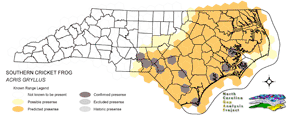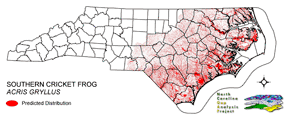| Code |
Name | Description |
NC Natural Heritage Program Equivalent |
| 380 | Coastal Plain Fresh Water Emergent
|
Emergent vegetation in fresh water seepage bogs, ponds and riverbeds of the coastal plain. Includes alliances dominated by sedges, eelgrass, as well as cane found in unforested cane-brakes.
|
Small Depression Pond, Sandhill Seep, Floodplain Pool, Unforested Floodplain Canebrake, Riverscour Prairies, Vernal Pools
|
| 173 | Coastal Plain Riverbank Shrubs
|
Shrub dominated riverbanks, commonly dominated by willows and/or alders.
|
Sand and Mud Bar
|
| 50 | Coastal Plain Mixed Bottomland Forests
|
Includes forests dominated by a variety of hardwood species, including sweetgum, cottonwood, red maple.
|
Coastal Plain Bottomland Hardwood (in part), Coastal Plain Levee Forest
|
| 49 | Coastal Plain Oak Bottomland Forest
|
Bottomland forests dominated by deciduous oak alliances. Oaks represented can include swamp chestnut, cherrybark, willow, and/or overcup oak. Inclusions of loblolly pine temporarily flooded forests occur in patches. Hydrology is temporarily to seasonally flooded.
|
Coastal Plain Bottomland Hardwoods (in part) blackwater subtype, brownwater subtype
|
| 15 | Seepage and Streamhead Swamps
|
Includes extensive peat flats in the coastal plain, dominated by swamp tupelo, maples, and Atlantic white cedar alliances. In the sandhills includes streamhead pond pine and bay forests alliances. Saturated hydrology.
|
Bay Forest, Small Depression Pocosin, Streamhead Atlantic White Cedar Forest, Streamhead Pocosins
|
| 30 | Cypress-Gum Floodplain Forests
|
Swamps dominated by black or swamp tupelo with or without Taxodium. Seasonally to semi-permanently flooded hydrology.
|
Cypress-Gum Swamps
|
| 78 | Pond-Cypress - Gum Swamps, Savannas and Lakeshores
|
Cypress dominated swamps and lakeshores. Can include bays dominated by pond cypress or shorelines of coastal plain lakes with a narrow band of cypress.
|
Non-riverine Swamp Forest, Natural Lakeshores (in part)
|
| 385 | Oak Bottomland Forest and Swamp Forest
|
The swamp chestnut oak, cherrybark oak, shumard oak and sweetgum alliance is one representative. Other alliances are dominated by water, willow, and overcup oaks. Swamp forests can be dominated by sweetgum, red maple, and black gum being dominant.
Loblolly can occur in combination with sweetgum and red maple, or with tulip poplar. Includes saturated and semi- to permanently flooded forests in the mountains.
|
Piedmont/Mountain Bottomland Forest, Piedmont/Mountain Swamp Forest
|
| 87 | Pocosin Woodlands and Shrublands
|
Includes pond pine woodland, low pocosin and high pocosin shrub dominated areas. Canebrakes and bay forests may be present.
|
Pond Pine Woodlands, Peatland Canebrake, Small Depression Pocosin
|
| 67 | Wet Longleaf or Slash Pine Savanna
|
Wet flatwoods and pine savannas, typically dominated by longleaf pines, but slash or pond pines may be the dominant pines.
|
Wet Pine Flatwoods
|
| 97 | Mesic Longleaf Pine
|
Longleaf pine woodlands without a major scrub oak component. Slash or loblolly pines may be present as well.
|
Mesic Pine Flatwoods
|
| 238 | Piedmont/Mountain Submerged Aquatic Vegetation
|
Seasonally to permanently flooded areas with aquatic vegetation. Waterlily, pondweed, hydrilla smartweed are a few of the species that can occur.
|
Piedmont/Mountain Semipermanent Impoundment (in part)
|
| 239 | Piedmont/Mountain Emergent Vegetation
|
Emergent vegetation of all wetland hydrologies. Sites would commonly support species such as tussock sedge, rushs, and cattail alliances.
|
Rocky Bar and Shore (in part)
|
| 267 | Riverbank Shrublands
|
Riverside shrubs with temporarily flooded hydrologies. Found in the both the Mountains and Piedmont. Containing dominants such as smooth alder and a Carolina or black willows.
|
Sand and Mud Bar
|
| 269 | Floodplain Wet Shrublands
|
Saturated shrublands of the Piedmont, includes buttonbush, swamp-loosestrife, decodon and alders.
|
Piedmont/mountain Semipermanent Impoundment
|
| 230 | Piedmont Mesic Forest
|
American Beech - Red Oak - White Oak Forests.
|
Mesic Mixed Hardwood
|
| 384 | Piedmont/Mountain Mixed Bottomland Hardwood Forests
|
Includes temporarily to seasonally forests dominated by hardwood species. Hardwoods include sweetgum, red maple, sycamore which co-occur in a mosaic of bottomland and levee positions. Includes alluvial hardwood forests in the mountains. Hemlock and white pine may occur as inclusions, but are generally mapped separately.
|
Piedmont/Mountain Alluvial Forest, Piedmont/Mountain Levee Forest
|
| 36 | Successional Deciduous Forests
|
Regenerating deciduous trees with a shrub stature. Commonly dominated by sweetgum, tulip poplars and maples.
|
No equivalent
|
| 180 | Agricultural Crop Fields
|
Farm fields used for row crops.
|
No equivalent
|
| 205 | Agricultural Pasture/Hay and Natural Herbaceous
|
Farm fields used for pasture grass or hay production, as well as old fields dominated by native and exotic grasses.
|
No equivalent
|
| 202 | Residential Urban
|
Includes vegetation interspersed in residential areas. Includes lawns, mixed species woodlots, and horticultural shrubs. Vegetation accounts for between 20 - 70% of the cover.
|
No equivalent
|
| 203 | Urban Low-Intensity Developed
|
Highly developed areas with vegetation accounting for < 20% of the cover.
|
No equivalent
|


